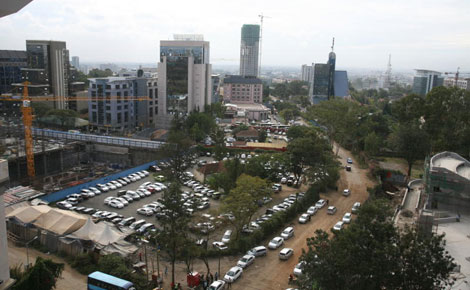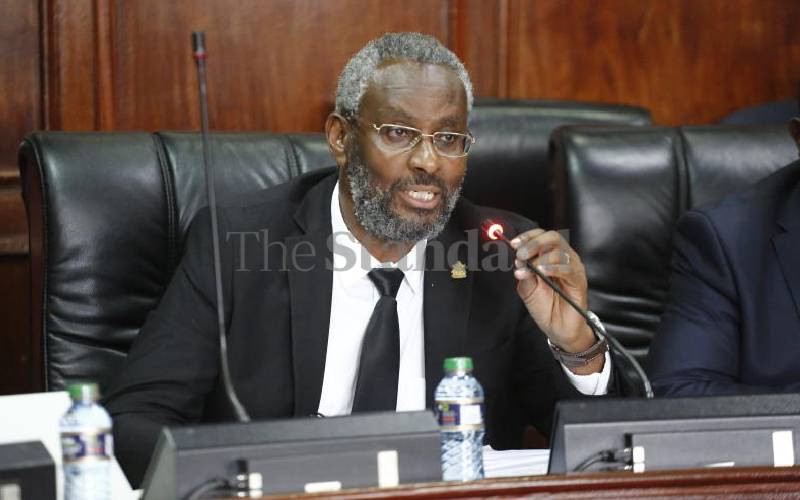 |
|
A section of buildings in Upper Hill taken on 26th May 2014. [PHOTO: WILBERFORCE OKWIRI] |
Despite being touted as a leading regional economic and social hub, it is emerging that Nairobi is lagging behind other African cities in terms of growth potential, at least according to the recently released Mastercard report.
The report, which has ranked Accra first for the second year running, places Nairobi 19th with a medium high-growth potential while Mombasa was ranked 40th and categorised as medium low-growth potential.
The 2014 Mastercard African Cities Growth Index report is based on different factors that help categorise a city as lagging behind or prospering in inclusive development. The 74 cities analysed were categorised according to population size.
The city of Nairobi, with an estimated population of nearly 3.5 million people, is lagging behind other big cities like Accra, Casablanca and Freetown when it comes to inclusive growth. Mombasa, the other Kenyan city highlighted in the report, is also lagging behind. Both Nairobi and Mombasa fell into the large cities category as each has over one million people.
According to the index, Nairobi is ranked 28th out of 80 cities based on lagging indicators. The rank places Nairobi above other developing cities like neighbouring Kampala, Dar es Salaam, Addis Ababa and Kinshasa and other known sub-Saharan cities like Johannesburg, Cape Town and Durban. Mombasa is ranked 46th.
The 12 lagging indicators describe conditions that have contributed to the status of the examined cities and include political stability and absence of violence, government effectiveness, regulatory quality, accountability, rule of law, control of corruption, doing business, population growth and middle class household growth.
"The leading indicators point to the emerging potential of cities. These are forward-looking and are determined by conditions, practice, policy and investment already in place or expected to be in place soon" said the report.
The indicators include gross fixed capital formation, availability of electricity, water and sanitation, health and education, Air Connectivity and Air Capacity, GDP Per capita growth, foreign direct investment, household consumption expenditure growth and mobile subscriptions. Here, Nairobi was ranked 32 and Mombasa was ranked 64th. Both cities were ranked lower than Kampala, Addis Ababa, Kinshasa and Dar es Salaam.
The MasterCard African Cities Growth Index maps the future success of Africa from the perspective of inclusive versus exclusive urbanisation, and by implication the economic outlook of the continent.
"Sub-Saharan Africa is urbanising quickly. According to United Nations estimates, 60 per cent of sub-Saharan Africa's population will be living in cities by 2050, almost doubling today's 36 per cent. The economic future of this vast continent will be determined in its cities," says the report.
The growth has also been facilitated by other factors which as the report cites, has been steady in the last two decades. "The first was the commodity windfall, which hugely improved the region's terms of trade. The second was increasing investment from China, related to China's demand for resources and its need to secure future supplies," says the report.
This has been visible in Kenya where the Kibaki administration spearheaded the move towards East as investment partners. President Uhuru Kenyata recently signed major deals with Chinese premier, showing his willingness to work with a government not strict on opening its purse.
In the case of Accra, the report says, there is inclusive growth which is shared and visible. Ghana's four successful generation elections was hailed as a sign of political maturity.
"For the second year, Accra ranked well across the assessment criteria and received one of the highest governance scores," says Prof Angelopulo of the University of South Africa. "The city is not Africa's most populous or richest in terms of per capita GDP, but has made progress towards conditions that are conducive to inclusive urbanisation."
The authors of the index clarified that as much as some of the leading cities in terms of growth potential might not appear to have the right structural foundations or governance, the resources to address these issues exist.
Stay informed. Subscribe to our newsletter
"Inclusive growth occurs when the benefits of an expanding economy are widely shared with the population," says Dr Hedrick-Wong, the Chief Economist at the MasterCard Centre for Inclusive Growth. "We believe that inclusive urbanisation is a prerequisite for inclusive growth, and so the ACGI is a lens through which African cities can be assessed as future investment destinations."
Casablanca and Freetown are ranked second and third in the large city category, with Tunis leading in the medium cities. Most of the leading cities are mainly in North and West Africa, while the small cities with the highest rankings are located in Africa's island states.
 The Standard Group Plc is a
multi-media organization with investments in media platforms spanning newspaper
print operations, television, radio broadcasting, digital and online services. The
Standard Group is recognized as a leading multi-media house in Kenya with a key
influence in matters of national and international interest.
The Standard Group Plc is a
multi-media organization with investments in media platforms spanning newspaper
print operations, television, radio broadcasting, digital and online services. The
Standard Group is recognized as a leading multi-media house in Kenya with a key
influence in matters of national and international interest.
 The Standard Group Plc is a
multi-media organization with investments in media platforms spanning newspaper
print operations, television, radio broadcasting, digital and online services. The
Standard Group is recognized as a leading multi-media house in Kenya with a key
influence in matters of national and international interest.
The Standard Group Plc is a
multi-media organization with investments in media platforms spanning newspaper
print operations, television, radio broadcasting, digital and online services. The
Standard Group is recognized as a leading multi-media house in Kenya with a key
influence in matters of national and international interest.









